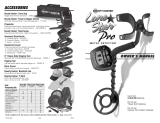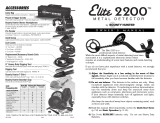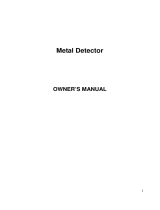Treasure Cove TC-3020 Owner's manual
- Category
- Measuring, testing & control
- Type
- Owner's manual

1
OWNER’S MANUAL
Fortune Finder ‘Platinum’ Edition TC-3020
GET THE LATEST UPDATED MANUAL FOR THIS
PRODUCT BY VISITING US FREQUENTLY AT
WWW.TREASURE-COVE.COM
Follow us or contact us on Facebook at
Facebook.com/TreasureCoveUSA
Need parts, tech support, or warranty assistance?
For fastest response, please visit us at:
www.treasure-cove.com/support/
You may also reach us: 805-288-5735

2
CONTENTS
Features……………………………………………………………………...
3
Preparation…………………………………………………………………..
4
Assembling the detector…………………………………………………
4
Installing the batteries……………………………………………………
5
Using headphones………………………………………………………..
5
Listening safely……………………………………………………………
6
Functions and indications…………………………………………………..
6
A quick look at the detector………………………………………………
6
Displays……………………………………………………………………
6
Tones………………………………………………………………………
7
Operation…………………………………………………………………….
8
Turning on the detector…………………………………………………
8
Setting the operation mode………………………………………………
9
Testing and using the detector…………………………………………..
9
Indoor testing and use…………………………………………………
10
Outdoor testing and use……………………………………………….
11
Search coil sweeping hints……………………………………………….
11
Adjusting sensitivity………………………………………………………
12
Application Hints…………………………………………………………….
13
Pinpointing the target…………………………………………………….
13
Factors that affect the detecting…………………………………………
14
Care and maintenance……………………………………………………...
14

3
With your metal detector, you can hunt for coins, relics, jewelry, gold, and silver
just about anywhere. The detector is versatile and easy to use.
The detector’s features include:
LCD Display—shows the probable type of metal with an arrow, the depth of
the target, DISC/NOTCH range, the level of SENS with segment, the operating
mode, and low battery indication.
Three Tone Audio Discrimination—sounds distinctive tones for different
types of metal.
Notch—ignores junk metal and finds valuable items by setting the disc and
notch range.
Super Slow Sweep Identification—with a very slow sweep of the search coil
to discriminate different types of metal.
Headphone Jack—lets you connect headphones (not supplied) and operate
without trouble.
Waterproof Search coil—lets you use the detector even if you must put it
under water.
Note: Your metal detector requires two 9-volt alkaline batteries (not supplied).
Control box Cable
Lock nut
Screw nut
Search coil

4
PREPARATION
ASSEMBLING THE DETECTOR
Assembling your detector is easy and requires no special tools. Just follow
these steps.
1. Slightly loosen the lock nut on the bigger stem. Insert the smaller
stem into the bigger one and tighten the lock nut.
2. Insert the latch on the top of the handle into the assembly hole on
the bottom of the control box. Then slightly push the control box in the
direction of IN marked on the handle to fix the latch in place. Secure
the control box with fixing screw properly.
Control box
Fixing screw
Assembly hole
latch
3. Unscrew the knob on the search coil and remove the knob connector.
Insert the stem and align the holes on the search coil bracket and the stem.
Push the connector through the holes and tighten the knob.
4. Wind the search coil cable around the stem. Leave enough slack in the
cable. Insert the search coil cable plug into the five pin jack on the front
control box’s housing.

5
5. Turn the stem’s lock nut clockwise until it loosens. Lengthen or shorten so
when you stand upright with the detector in your hand, the search coil is level
with and about 1/2 to 2 inches above the ground with your arm relaxed at
your side. Turn the stem’s lock nut counter-clockwise to lock it in place.
Caution:
The search coil’s plug fits into the connector only one way. Do not force the
plug or you could damage it.
Do not over tighten the search coil or use tools such as pliers to tighten it.
INSTALLING THE BATTERIES
Cautions:
Use only fresh alkaline batteries of required size.
Do not mix the old and new batteries or different types of batteries.
1.
Slide the POWER button to turn on the power.
2.
Slide the left and right battery covers off in the direction of the arrow.
3.
Place a 9V battery into the battery compartment matching the polarity
symbols (+ and -) marked inside.
Warning:
Dispose of old batteries promptly and properly. Never bury or burn them.
Caution:
If you don’t plan to use the unit for a week or more time, remove the
batteries. Batteries can leak chemicals that can destroy electronic parts.
To extend the battery life, exchange the left and right battery after

6
3~4hours of operation.
USING HEADPHONES
1.
Insert the headphones’ 3.5mm plug into the PHONE jack. At this time the
internal speaker disconnects.
2.
Set the VOLUME to the desired setting.
PHONE
Listening Safely
To protect your hearing, set the volume to the lowest setting before you
begin listening, adjust the volume to a comfortable level.
Do not listen at extremely high volume levels. Extended high volume
listening can lead to permanent hearing loss.
Do not wear headphones while operating your detector near high-traffic
areas. Pay attention to traffic safety.
FUNCTIONS AND INDICATIONS
1.
A QUICK LOOK AT THE DETECTOR

7
2.
DISPLAYS
The indicator of target includes target icons and LCD displays and is located
at the top of the detector. It can indicate coins of different type, gold, silver
etc. When the detector detects an object, an arrow appears below the target
icon of probable type of metal being detected. Also displays the depth of the
target. If the detector receives a strong signal, the arrow appears steadily. If
the signal is weak, the arrow blinks or does not appear.
Note:
If the detecting pauses for about 5 seconds, the arrow will disappear.
If an arrow points to a coin denomination, the detector might be
detecting either a coin or another type of metal (such as jewelry, tokens,
medals, or even junk metal) of similar size and type to the coin.
Since the indications are approximations, the detector might not have
actually found the item it indicates. The indicator is only a visual
reference to help you decide if an item is worth investigating.
M E T A L I C O N S
SENSITIVITY
LEVEL L O W B A T T
OPERATION MO DE
BUTTONS
T A R G E T I N D I C A T I O N
DISC/NOTCH R ANGE
DEPTH
SENSITIVITY
DISC/NOTCH C O N T R O L
I N D I C A T I O N
GOLD Range
IRON FOIL—indicates that the target is probably iron or foil. Some oxidized
iron might register somewhere within the SILVER range.
5¢(NICKEL) —indicates that the target is probably 5¢ or a nickel. Some small
gold rings might register within this range.
PULL TAB -indicates that the target is probably a pull tab of an aluminum
can. Some small gold rings might register within this range.

8
might register within PULL TAB category.
S-CAPS—indicates that the target is probably a type of metal like bottle cap
with whorl. Some medium sized gold rings might register within this category.
1¢—indicates that the target might be a zinc penny or a copper coin. Some
large rough gold items might register within 1¢ category.
SILVER Range
1¢ 25¢--indicates that the target is probably silver coin, 25¢ or 1¢. Some large
aluminum coin might register within 1¢ 25¢ category.
TONES
If the detector is set to the ALL METAL target mode, it sounds a single
tone when it detects any type of metal. If you set the detector to the
DISC or NORTCH modes, the built in audio identification system
sounds a unique audio tone for each of three categories of metal. This
makes it easier to identify the metal being detected.
The detector sounds a low tone when it detects foil, nail, bottle cap or
nickels. A medium tone for aluminum pull tabs, zinc or copper items. A
high tone is for brass or silver items.
Notes:
When you set the detector to DISC or NOTCH mode, the detector
sounds a medium or high tone when it detects highly oxidized iron.
An arrow appears in medium or high tone area.
Depending on the quality, about 15 percent of gold rings cause the
detector to sound a medium tone.
L O W T O N
E
M E D IU M T O N E

9
OPERATION
TURNING ON THE DETECTOR
1. Slide the power switch to ON. The unit displays all symbols on the
LCD screen. The detector sounds low , medium, high tones
respectively. After about 2 seconds the detector enters stand-by state.
At this time the LCD displays ALL METAL and SENS. The value of
SENS on the segment is 5. The range from MIN. to MAX. for
DISC/NOTCH is available.
2. SETTING THE OPERATION MODE
The detector comes with three operating modes of ALL METAL, DISC,
NOTCH. You can select the desired mode by relative touch key.
a. ALL METAL—used for detecting any type of metal. When the
detector detects any type of metal, it sounds a tone.
Note: When you operate in this mode, controls of DISC and NOTCH do
not function except SENS. To adjust the sensitivity, first press SENS
and UP to increase the sensitivity, then press Dn to decrease it.
b. DISC—used for target discrimination. You can set the target range
from MAX to MIN by pressing DISC/NOTCH and UP & Dn keys. The
detector can detect the metal type indicated on the display.
Meanwhile the detector rejects other metal types without displaying
on the screen. For example, press Dn key, 4 levels on segment from
Max to Min is increased. At this time, the detector can detect S- CAPS,
1¢ and also 25¢, other types of metal are rejected.
c. NOTCH—to ignore the metal type you do not want. You can select

10
the metal type desired by pressing the UP and Dn keys. The LCD
segment will indicate the selected types of metal. The detector can
detect the selected metal type.
TESTING AND USING THE DETECTOR
To learn how the detector reacts to different metals, you should test it
before you use it the first time. You can test the detector indoors and
outdoors.
Indoor Testing and Use
1. Slide POWER to ON
2. Set the operating mode.
3. Place the detector on a wooden or plastic table, then remove any
watches, rings, or metal jewelry you are wearing.
4. Adjust the search coil so the flat part points towards the ceiling.
Note:
Never test the detector on a floor inside a building. Most buildings have
metal of some kind in the floor, which might interfere with the objects
you’re testing or mask the signal completely.
5. Slowly sweep a sample of the material you want the detector to find
(such as a gold ring or a coin) 2-3 inches or more above the face of
the search coil. When the detector detects any metal, it sounds a
tone and an arrow appears below the target icon. Also LCD displays
the depth of the target.
Note:

11
If you are using a coin, the detector will detect it more easily if you hold
it so a flat side is parallel with the flat side of the search coil. A sweep
with the side of coin over search coil might cause false indication and
unstable display of arrow.
Outdoor Testing and Use
1. Slide POWER to ON. Set the operating mode.
2. Find an area on the ground outside where there is no metal.
3. Place a sample of the material you want the detector to find (such
as a gold ring or a coin) on the ground.
Note:
If you are using valuable metal such as gold to test the detector, mark
the area where you place the item, to help you find it later. Do not place
it in tall grass or weeds).
4. Hold the search coil level to the ground about 1~2 inches above the
surface, slowly move the search coil over the area where you
placed the sample, sweeping the search coil in a side-to-side
motion.
Search coil Sweeping Hints:
Never sweep the search coil as if it were a pendulum. Raising the
search coil while sweeping or at the end of a sweep will cause
false readings.
Correct
Wrong

12
Sweep slowly hurrying will cause you to miss targets.
It’s better you sweep the search coil from side to side in an arc line
of 3 inches motion and keep the search coil parallel with the ground.
If the detector detects the item, it sounds a tone, an arrow and the
depth appear on the display below the target icon.
If the detector does not detect the item, make sure that the target mode
is set correctly for the type of metal you’re searching for. Also make
sure that you’re moving the search coil correctly.
Notes:
The detector responds with a signal when it detects most valuable
metal objects. If a signal does not repeat after you sweep the
search coil over the target a few times, the target is probably junk
metal.
False signals can be caused by trashy ground, electrical
interference, or large irregular piece of junk metal.
False signals are usually broken or non-repeatable.
Adjusting SENSITIVITY
After you become familiar with how your detector works, it’s important to
fine tune the sensitivity to get a good effect.
Press the touch button SENS on the panel. Then press UP or Dn to
increase or decrease the sensitivity. The level on the segment will
be displayed from high to low position.
Note:
In order to detect the target deeply buried, you can adjust the SENS

13
to a high position. But not to set the level of SENS to Max position,
or the detector will receive interference and false signal from
broadcast antenna and other electronic lines. The detector will have
unstable arrow and irregular tone indications.
Application Hints
Pinpointing The Target
Accurately pinpointing a target makes digging it up easier. But it takes
practice. We suggest you practice finding sample on your own property
before you search other locations.
Follow these steps to pinpoint a target.
1. When the detector detects a buried target, continue sweeping the
search coil over the target in a narrowing side-to-side motion.
2. Make a visual note of exact spot on the ground where the detector
beeps.
3. Stop the search coil directly over this point on the ground. Then move
the search coil straight forward away from you and straight back
towards you a couple of times.
4. Repeat steps 1~3 at a right angle to the original search line, Make a
mark of “X” . The target will be directly below the “X” at the point of
the beep response.
Factors That Affect The Detecting
It’s difficult to have an accurate detecting result. Sometimes the
detecting may be restricted by some factors.

14
1. Conditions For The Target Being Detected
The angle of the target buried in the soil.
The depth of the target.
The level of oxidization of the target.
The Size of the target.
Electro-magnetic and electrical interference surrounding the
target.
If you detect patiently and correctly and practice more times, you’ll
get satisfactory result.
CARE AND MAINTENANCE
Your TC-3020 metal detector is an example of superior design and
craftsmanship. The following suggestions will help you care for your
metal detector so you can enjoy it for years.
Handle the detector gently and carefully. Dropping it can
damage circuit boards and cases and can cause the
detector to work improperly.
Use the detector only in normal temperature
environments. Temperature extremes can shorten the life
of electronic devices, damage the cases of the detector.
Keep the detector away from dust and dirt, which can
cause premature wear of parts.
Wipe the detector with a damp cloth occasionally to keep
it looking new. Do not use harsh chemicals, cleaning
solvents, or strong detergents to clean the detector.

15
State of California PROP 65: WARNING: This product can expose you to chemicals including
lead which is known to the State of California to cause cancer. For more information, go to
www.P65Warnings.ca.gov.
GET THE LATEST UPDATED MANUAL FOR THIS
PRODUCT BY VISITING US FREQUENTLY AT
WWW.TREASURE-COVE.COM
Follow us on Facebook at
Facebook.com/TreasureCoveUSA
-
 1
1
-
 2
2
-
 3
3
-
 4
4
-
 5
5
-
 6
6
-
 7
7
-
 8
8
-
 9
9
-
 10
10
-
 11
11
-
 12
12
-
 13
13
-
 14
14
-
 15
15
Treasure Cove TC-3020 Owner's manual
- Category
- Measuring, testing & control
- Type
- Owner's manual
Ask a question and I''ll find the answer in the document
Finding information in a document is now easier with AI
Related papers
Other documents
-
Sharper Image Pro Digital Metal Detector Owner's manual
-
Platinum HAIN3050 User manual
-
Coopers 8042 User manual
-
Platinum GC-1037 User manual
-
Kogan KA3MTANDETA User guide
-
 Bounty Hunter 3410013 Owner's manual
Bounty Hunter 3410013 Owner's manual
-
 Bounty Hunter PROLONE Owner's manual
Bounty Hunter PROLONE Owner's manual
-
Bounty Hunter 3410009 Owner's manual
-
 Bounty Hunter Elite 2200 Owner's manual
Bounty Hunter Elite 2200 Owner's manual
-
 American Hawks METAL20 Owner's manual
American Hawks METAL20 Owner's manual





















